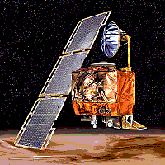The Devil's In The Details
 Did you ever make a mistake converting English numbers to metric numbers? Let's hope that your mistake didn't cost anyone $125 million dollars. That's what happened to NASA. The Mars Climate Orbiter's mission to study Martian weather and climate was a part of NASA's faster-better-cheaper philosophy of the 1990s. On September 23, 1999, after firing its main engine to enter an orbit around the planet Mars, it crashed into the planet and was destroyed. So what happened?
Did you ever make a mistake converting English numbers to metric numbers? Let's hope that your mistake didn't cost anyone $125 million dollars. That's what happened to NASA. The Mars Climate Orbiter's mission to study Martian weather and climate was a part of NASA's faster-better-cheaper philosophy of the 1990s. On September 23, 1999, after firing its main engine to enter an orbit around the planet Mars, it crashed into the planet and was destroyed. So what happened?
The mission had proceeded normally and was believed to be on track as the spacecraft went behind Mars causing a planned 20 minute loss of its signal as it was occulted by the planet (occult means to hide). The 20 minutes came and went with no resumption of contact with the spacecraft. NASA now believes that the Mars Climate Orbiter was destroyed because of a navigation error which caused a much lower angle of descent into the Martian atmosphere, an angle of descent outside the structural capabilities of the spacecraft. NASA's disappointment was understandable. What wasn't understandable was the reason that the target altitude of 80 to 90 kms was missed.
To quote NASA, '[t]he 'root cause' of the loss of the spacecraft was the failed translation of English units into metric units in a segment of ground-based, navigation-related mission software, as NASA has previously announced.' In plain English, spacecraft engineers failed to coordinate their numbers. It turns out that a team of engineers at NASA was using metric numbers to calculate the target altitude, while the company that built the spacecraft was using feet and inches. A trip of 35 million miles was destined to failure because of a few inches and millimeters. So next time you're doing some math problems, remember what your teacher told you -- check your work.
About the Author
Gene Mascoli, JD
 Gene Mascoli is a founder and publisher of ScienceIQ.com. He holds a J.D. degree from the University of Santa Clara and a B.A. in English. In 1997 Gene launched ScienceMaster.com, an online science education portal where he brought together his love of writing with his interest in the sciences. Gene collaborated with David Gamon on the popular digital book
“The Internet Guide to NASA on the Net” and has also produced two popular science CD-ROMs on astronomy and space science.
Gene Mascoli is a founder and publisher of ScienceIQ.com. He holds a J.D. degree from the University of Santa Clara and a B.A. in English. In 1997 Gene launched ScienceMaster.com, an online science education portal where he brought together his love of writing with his interest in the sciences. Gene collaborated with David Gamon on the popular digital book
“The Internet Guide to NASA on the Net” and has also produced two popular science CD-ROMs on astronomy and space science.


